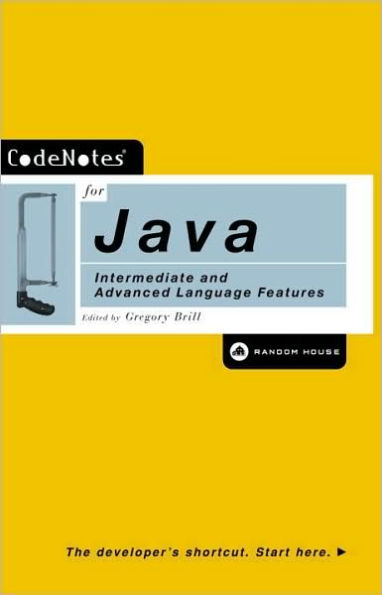CodeNotes for Java: Intermediate and Advanced Language Features
CodeNotes provides the most succinct, accurate, and speedy way for a developer to ramp up on a new technology or language. Unlike other programming books, CodeNotes drills down to the core aspects of a technology, focusing on the key elements needed in order to understand it quickly and implement it immediately. It is a unique resource for developers, filling the gap between comprehensive manuals and pocket references.
CodeNotes for Java: Intermediate and Advanced Language Features will introduce the reader with a grasp of basic Java to advanced object oriented design techniques, collections, I/O, multi-threaded applications, internationalization and more. Experienced Java programmers will also benefit from the numerous examples, tips and tricks and design notes that explain why these Java features are fundamentally important to every development effort.
This edition of CodeNotes includes:
-A global overview of a technology and explanation of what problems it can be used to solve
-Real-world examples
-"How and Why", and "Bugs and Caveats" sections that provide hints, tricks, workarounds, and tips on what should be taken advantage of or avoided
-"Design Notes" illustrating many of the common use patterns for Java programs
-Instructions and classroom-style tutorials throughout from expert trainers and software developers
Visit www.codenotes.com for updates, source code templates, access to message boards, and discussion of specific problems with CodeNotes authors and other developers.
Every CodeNotes title is written and reviewed by a team of commercial software developers and technology experts. See "About the Authors" at the beginning of the book for more information.
1100623859
CodeNotes for Java: Intermediate and Advanced Language Features will introduce the reader with a grasp of basic Java to advanced object oriented design techniques, collections, I/O, multi-threaded applications, internationalization and more. Experienced Java programmers will also benefit from the numerous examples, tips and tricks and design notes that explain why these Java features are fundamentally important to every development effort.
This edition of CodeNotes includes:
-A global overview of a technology and explanation of what problems it can be used to solve
-Real-world examples
-"How and Why", and "Bugs and Caveats" sections that provide hints, tricks, workarounds, and tips on what should be taken advantage of or avoided
-"Design Notes" illustrating many of the common use patterns for Java programs
-Instructions and classroom-style tutorials throughout from expert trainers and software developers
Visit www.codenotes.com for updates, source code templates, access to message boards, and discussion of specific problems with CodeNotes authors and other developers.
Every CodeNotes title is written and reviewed by a team of commercial software developers and technology experts. See "About the Authors" at the beginning of the book for more information.
CodeNotes for Java: Intermediate and Advanced Language Features
CodeNotes provides the most succinct, accurate, and speedy way for a developer to ramp up on a new technology or language. Unlike other programming books, CodeNotes drills down to the core aspects of a technology, focusing on the key elements needed in order to understand it quickly and implement it immediately. It is a unique resource for developers, filling the gap between comprehensive manuals and pocket references.
CodeNotes for Java: Intermediate and Advanced Language Features will introduce the reader with a grasp of basic Java to advanced object oriented design techniques, collections, I/O, multi-threaded applications, internationalization and more. Experienced Java programmers will also benefit from the numerous examples, tips and tricks and design notes that explain why these Java features are fundamentally important to every development effort.
This edition of CodeNotes includes:
-A global overview of a technology and explanation of what problems it can be used to solve
-Real-world examples
-"How and Why", and "Bugs and Caveats" sections that provide hints, tricks, workarounds, and tips on what should be taken advantage of or avoided
-"Design Notes" illustrating many of the common use patterns for Java programs
-Instructions and classroom-style tutorials throughout from expert trainers and software developers
Visit www.codenotes.com for updates, source code templates, access to message boards, and discussion of specific problems with CodeNotes authors and other developers.
Every CodeNotes title is written and reviewed by a team of commercial software developers and technology experts. See "About the Authors" at the beginning of the book for more information.
CodeNotes for Java: Intermediate and Advanced Language Features will introduce the reader with a grasp of basic Java to advanced object oriented design techniques, collections, I/O, multi-threaded applications, internationalization and more. Experienced Java programmers will also benefit from the numerous examples, tips and tricks and design notes that explain why these Java features are fundamentally important to every development effort.
This edition of CodeNotes includes:
-A global overview of a technology and explanation of what problems it can be used to solve
-Real-world examples
-"How and Why", and "Bugs and Caveats" sections that provide hints, tricks, workarounds, and tips on what should be taken advantage of or avoided
-"Design Notes" illustrating many of the common use patterns for Java programs
-Instructions and classroom-style tutorials throughout from expert trainers and software developers
Visit www.codenotes.com for updates, source code templates, access to message boards, and discussion of specific problems with CodeNotes authors and other developers.
Every CodeNotes title is written and reviewed by a team of commercial software developers and technology experts. See "About the Authors" at the beginning of the book for more information.
10.99
In Stock
5
1

CodeNotes for Java: Intermediate and Advanced Language Features
256
CodeNotes for Java: Intermediate and Advanced Language Features
256
10.99
In Stock

Product Details
| ISBN-13: | 9780679647294 |
|---|---|
| Publisher: | Random House Publishing Group |
| Publication date: | 01/23/2002 |
| Series: | CodeNotes |
| Sold by: | Random House |
| Format: | eBook |
| Pages: | 256 |
| File size: | 546 KB |
About the Author
From the B&N Reads Blog
